Bird’s Nest Helsinki (2004)
The Bird’;s Nest continues the collaboration between installation artist Jan-Erik Andersson and sound artist Shawn Decker. This is a site-specific public work that includes sculptural and sound elements. This particular version of the nest was shown as part of the Kiasma Museum of Contemporary Art’s exhibition, Wireless Experience, coinciding with ISEA 2004, and was situated in the lobby of the Helsinki Sonomat, adjacent to the museum. In this installation, the nest was used as part of a café, where people could sit and drink coffee, etc. at tables inside the nest
The Bird’s Nest in part explores new ways of developing architecture based on forms found in nature. These forms are combined with kinetic sound works that are likewise derived directly from natural processes. The artists see these acoustic and kinetic elements as functioning within the context of architecture as a kind of ornamentation, broadening of the concept of the ornament to include sound and rhythm.
Although the Bird’s Nest looks chaotic, it is made of a single, geometric, triangular shaped wooden modules. The concept of the module has been widely used in modernist architecture, resulting in monotonous buildings with repeated patterns. In the Bird’s Nest’s structure, however, the arrangement of the triangular modules in a semi-chaotic manner creates a space which is more organic and rooted in structures found within natural systems.
Visitors are invited to sit down by tables inside the Nest and experience the transparency of the structure and how it allows the surrounding environment to be a part of the experience, yet held at a distance as well. In this version of the Nest, made for the ISEA exhibition, one of the most interesting aspects of this was the contrast between the exacting geometries of the large modernist steel and glass atrium, and the chaotic construction of the nest.
In the Helsinki nest, piano wires form a transparent roof over the Nest, and use the nest as a sounding board to create rhythmic patterns when the piano wires are struck by small electric motors. The sounds are constantly changing and never repeat, being generated by a computer program modelling patterns and processes directly derived from nature (in particular, from the patterns of local birdsong). As a sounding board, each separate stick of the sounding board yields a small amount of sound. Inside the nest, surrounded by these sounds, the listener is cocooned with the sound environment, which is quite audible, whereas outside the environment, where the listener can only be near to a small number of these sticks and the sounds are quite quiet. The constant change of the sounds, without repetition ever, directly corresponds to the sounds of the natural environment, and in turn contrasts with the overwhelming presence of recorded media in our contemporary culture, which has desensitized us to the subtle and complex processes and this constant change found in nature.
Watch Video Documentation:





